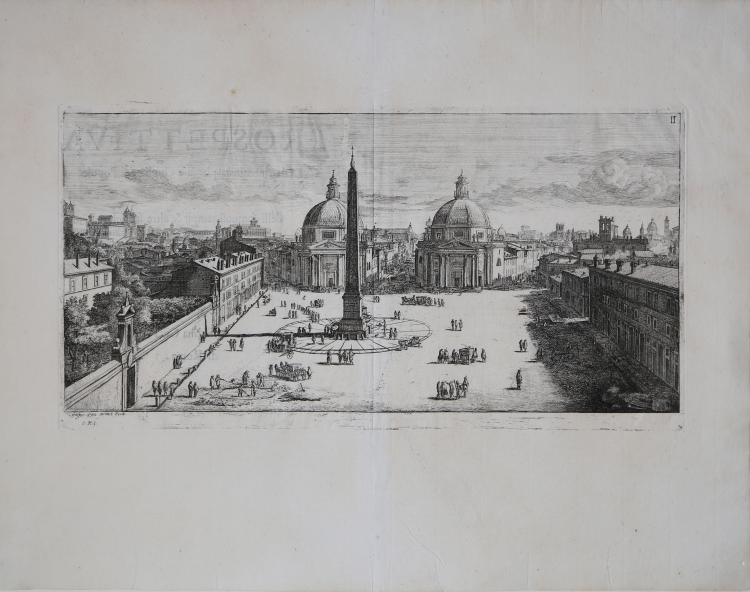- New




| Reference: | S52101 |
| Author | Gaspar Adriaensz van Wittel |
| Year: | 1678 ca. |
| Printed: | Rome |
| Measures: | 425 x 220 mm |



| Reference: | S52101 |
| Author | Gaspar Adriaensz van Wittel |
| Year: | 1678 ca. |
| Printed: | Rome |
| Measures: | 425 x 220 mm |
The Piazza del Popolo in Rome, with the obelisk at centre.
Etching, 1678 circa, signed at lower left Gasper van Wittel Fecit. After Cornelis Meijer.
Example of the second state of three, with the signature added and before the title Porspettiva della rinommata piazza e Guglia del Popolo.
The plate is part of Cornelis Meijer's "L'arte di restituire à Roma" (Rome: 1683).
The print depicts Piazza del Popolo before Giuseppe Valadier's urban planning works in 1793. The square was the entrance to the Eternal City for those arriving from the north along the Via Flaminia, and from the image we can recognize the twin churches dedicated to Santa Maria di Montesanto on the left and Santa Maria dei Miracoli, with Via del Corso in the center and Via del Babuino and Via di Ripetta on either side. In the left foreground, we can see the obelisk known as Flaminio, erected by Domenico Fontana in 1589, suggesting that the viewpoint is the former Augustinian convent, now the headquarters of the Carabinieri.
There is very little information about Gaspar Van Wittel (who Italianized his name to Gaspare Vanvitelli) but suggests a rather unique education and approach. We know that he was born in Amersfoort, near Utrecht, in 1652 or 1653, became a student of Mathias, and arrived in Rome in 1674 at the age of twenty. Between 1675 and 1676, he collaborated with his compatriot Cornelis Meyer, a hydraulic engineer, drawing fifty topographical views intended to illustrate a treatise on the possibilities of making the Tiber navigable from Perugia to Rome. In 1675, under the nickname De Toorts (the Torch), he joined the group of Dutch artists in Rome known as Schildersbent ("band of painters"). His first dated paintings date from 1680, already perfectly in keeping with the mature style of the painter. He was shortsighted and would later be nicknamed "Gaspare degli Occhiali" (Gaspare of the Glasses) for the lenses he used to work on his meticulous views.
Van Wittel brought the tradition of Dutch landscape painting to the Roman context, establishing the urban view as an independent genre. His art is distinguished by a rational approach to perspective, derived from the Flemish school, and by a meticulous attention to architectural detail, blending topographical rigor with a poetic vision of the city.
A magnificent work, printed on contemporary laid paper, with wide margins and the usual vertical center fold. In excellent condition. Title in typeface printed on the verso.
Bibliografia
Hollstein, Dutch and Flemish etchings, engravings and woodcuts c.1450-1700, n. 3, II/III.
Gaspar Adriaensz van Wittel (Amersfoort 1653 – Roma 1736)
|
Dutch painter, draughtsman and etcher. Born in Amersfoort, and pupil of Matthias Withoos, in 1674 he moved in Rome, assisting the Dutch engineer and scientist Cornelis Maijer. In 1686 he became a member of the Congregazione dei Virtuosi al Pantheon. In 1688 married Anna Lorenzani (or Laurentini) in Rome and in 1709 he accorded the Roman citizenship. In 1711 confirmed as a member of the Accademia di San Luca in Rome. Between 1694 and 1710, he toured Italy and painted in Florence, Bologna, Ferrara, Venice, Milan, Piacenza and Naples. He is one of the principal painters of topographical views known as vedute.
His son Luigi would become a famous architect and also carries the italianized family name of Vanvitelli.
|
Gaspar Adriaensz van Wittel (Amersfoort 1653 – Roma 1736)
|
Dutch painter, draughtsman and etcher. Born in Amersfoort, and pupil of Matthias Withoos, in 1674 he moved in Rome, assisting the Dutch engineer and scientist Cornelis Maijer. In 1686 he became a member of the Congregazione dei Virtuosi al Pantheon. In 1688 married Anna Lorenzani (or Laurentini) in Rome and in 1709 he accorded the Roman citizenship. In 1711 confirmed as a member of the Accademia di San Luca in Rome. Between 1694 and 1710, he toured Italy and painted in Florence, Bologna, Ferrara, Venice, Milan, Piacenza and Naples. He is one of the principal painters of topographical views known as vedute.
His son Luigi would become a famous architect and also carries the italianized family name of Vanvitelli.
|